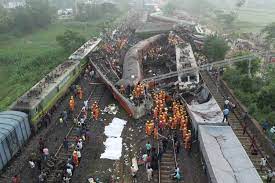Manas Dasgupta
NEW DELHI, June 3: Questions are being raised about possible operational lapses that could have contributed to the horrific train accident near Balasore in Odisha on Friday evening involving three trains.
With still contradictory reports are coming about the possible causes of the accident, the fourth worst in the history of Indian Railways, the government sources said the high-level committee to be appointed to probe into the accident would be asked to investigate all angles including mechanical error, human error and sabotage.
The incident took place when a passenger train, the Coromandel Express from Shalimar station, Kolkata, to Chennai derailed and hit a goods train, and another passenger train, Yashwantpur (Bengaluru) – Howrah Superfast crashed into the derailed coaches of Coromandel Express.
“Two passenger trains had an active involvement in the accident while the third train, a goods train, which was parked at the site, also got (involved) in the accident,” Amitabh Sharma, executive director, Indian Railways said.
While many theories are being advanced about the possible causes of the accident, it was clear that between 6.50 PM and 7.10 PM two collision occurred at the same place between three trains, leaving a mass of wrecked compartments and coaches on top of one another.
A passenger train, the Coromandel Shalimar Express, derailed after hitting a parked goods train and another train, the Yashwantpur-Howrah Superfast, crashed into the derailed coaches. The impact was so hard that coaches were lifted high into the air before they smashed onto the tracks. One coach was tossed on its roof. Seventeen coaches of the two trains were severely damaged.
There are more than one versions of how the back-to-back crashes took place, but what is certain is that there were three trains and two collisions at the same spot. Among the many questions surrounding the accident is how the Coromandel Shalimar Express was on the same track as the stationary goods train.
The Indian Railways’ system of tracking rail traffic throw some light into the moments just before three trains collided. The yard layout, or diagram used by railway traffic officers showing tracks in an intersection, indicates the position of the three trains at the time of the accident.
In the diagram, the middle line is the “UP line”, where the Shalimar-Chennai Central Coromandel Express was coming and on the other line marked as “DN main”, the Bengaluru-Howrah Superfast Express was crossing.
Some coaches of Coromandel Express derailed, after which they hit a goods train on the adjacent tracks, and some coaches also fell on the “DN main” line. The Bengaluru-Howrah train then rammed the derailed coaches of the Coromandel Express. Both the trains were running at very high speeds when collided with 17 passenger coaches of the two trains badly damaged.
Some railway experts have, however, have expressed doubt that Coromandel Express may have hit the goods train directly inside a “loop line.” Visuals show the Coromandel Express’ engine resting on top of the goods train, indicating a straight collision. A detailed investigation would only reveal how the Coromandel Express was diverted to the loop line. A “loop line” divides from the main railway tracks and returns to the mainline after some distance. These help manage busy rail traffic.
Rescue operations continued overnight as workers and local people tried to pull out bodies and survivors from the mangled wreckage. Visuals from the crash site showed smashed train coaches torn open and twisted train tracks.
The Railways Ministry has been in the process of installing an anti-collision system “Kavach” across the country. Kavach alerts when a train jumps a signal (Signal Passed at Danger — SPAD), which is the leading cause of train collisions. The system can alert the train driver, take control of the brakes and stop the train when it notices another train on the same tracks.
Kavach was not available on the route involved in the accident, said Railways spokesperson Amitabh Sharma.
The worst-affected parts of the Coromandel Express were the Sleeper class coaches, which are usually packed as during the holidays even non-reserved passengers get in.

